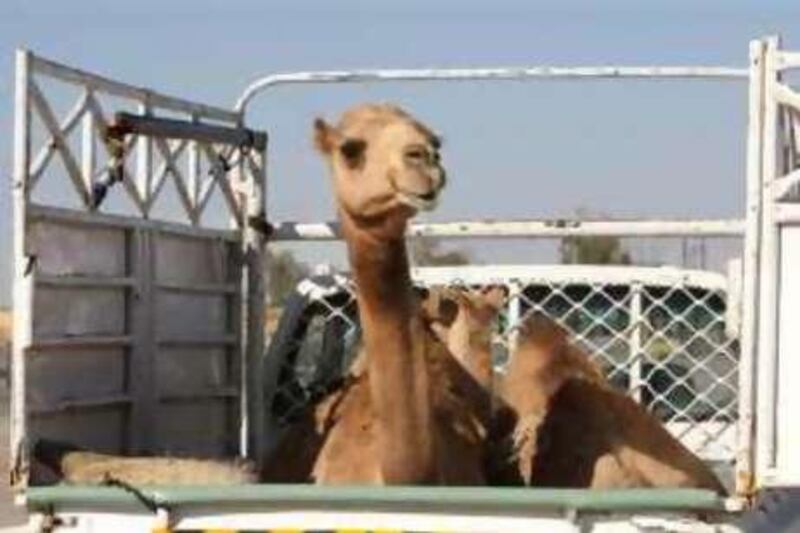ABU DHABI // "The maidens commenced throwing the camel's flesh into the kettle. "The fat was woven with the lean like loose fringes of white twisted silk." So reads an ode by a sixth-century Arab poet.
Imru al Qais, the bard of the pre-Islamic era, had killed his riding camel to impress a group of women bathing at the Darat Juljul spring. Qais's generosity was for a special occasion and, 15 centuries later, the animal's meat is still regarded as a delicacy. The wedding season has begun and the demand for camel meat is on the rise. At markets, young camels are being eyed up by buyers trying to decide whether the young beasts are fleet of foot or best suited to the dinner table.
In the world of the camel aficiando, "fast" and "food" are two words that rarely belong together. An Emirati wedding involving a massive banquet would have several camels roasted whole. They are served on huge platters heaped with basmati rice spiced with saffron and other colourful herbs. In dining halls with room for more than 500 men, the camels are served only to guests of honour. The rest are given roast mutton.
Mofeed Abdul Rahman, the manager of Al Dhafra Tourist Village restaurant, will be busy throughout the summer catering daily for marriage festivities. "The number of whole camels depends on how many VIPs there are," says Mr Rahman, as he stands next to an electronic oven, which takes at least six hours to cook a whole camel. He says the average number of camels at wedding feasts was three or four. Ahmad Ali, a chef from Yemen, says: "It's part of tribal traditions. The man would be proud to kill several camels [for food]."
Mr Ali works at the Saudi Kitchen at Port Zayed and he has spent the past 27 years cooking traditional Arab food in Saudi Arabia and the UAE. In this kitchen, however, he started cooking camel meat only five months ago. Wedding caterers are not in short supply, but in Abu Dhabi a camel-meat lunch box delivered to your home is a rare commodity. The Saudi Kitchen sells fewer than two dozen a day. Mr Ali prepares the meat either by boiling or roasting it in the tanour, a wood-fuelled oven shaped like a barrel.
In this oven, the chef wraps the meat, usually with vegetables and green chillies, in aluminium foil and leaves it to grill in the heat of a flameless fire. The flames die down when the tanour's lid is shut. In Mazyad market, on the outskirts of Al Ain, the scene is different. Groups of men struggle to force camels into pick-up trucks or lorries. The kicking and groaning camels finally stop resisting when they find themselves aboard the vehicles. For many of these animals, it is the beginning of a short trip to the slaughterhouse.
A camel destined for meat costs from Dh1,000 (US$270) to Dh4,000, the price determined by weight, which is usually estimated without scales. Musallam Selmi Atiq, of the Rashaida tribes in eastern Sudan, normally sells two or three camels a day but can sell as many as 15 in the wedding season. "People prefer young camels when they have a private feast, but if they want to give out meat, they buy bigger camels," says Mr Atiq, who had 15 camels on sale, most of them under three years old.
Abdul Aziz bin Salama, 18, drove from Abu Dhabi to buy camels for a family banquet. He bought two, one for Dh900 and the other for Dh1,200. "We love camel meat because it's an old habit. It's healthy and is mentioned in the Quran," he says before driving off behind the lorry transporting the two camels. The market is dominated by Sudanese men who hail from tribes that specialise in raising camels and other livestock in areas such as Kasala.
Mr Atiq has been dividing his time between Sudan and the UAE for the past 16 years. He is 41 and has seven children aged from two to 17. "I have been dealing with camels since I was very little," he says. The tribesman can effortlessly reel off dozens of words describing the life stages of a camel, from birth to the end of its life. Other words describe the animal's breed and physical appearance.
Most of these words can be found in classical Arabic dictionaries. The camel has fascinated Arab poets through the generations. Linguists, for their part, wrote passionate and elaborate descriptions, with one treatise compiled in the ninth century wholly dedicated to defining words related to the species. The dusty market, near Jebel Hafeet mountain, is divided into several sections. In some, camels are on display for their breeding potential, while others are shown for their beauty or racing ability.
Emirati men, many in four-wheel drives, circle the market in the hope of spotting a camel which, after prolonged training and grooming, could earn them a fortune. Others, such as Abdullah Salem, a 25-year-old Emirati from Al Ain, come to sell a specific type. His commodity is a beauty beast, a model camel that could enter the annual camel contest and be sold for thousands, if not millions, of dirhams.
Mr Salem does not have the camel tied by its hind legs in the back of a lorry. Instead, he shows prospective buyers a digital picture of the animal saved on his mobile phone. Racing and beauty camels can be notoriously expensive. But neither are commonly found in the Al Ain souq. This is a venue for amateur treasure hunters. "It happens about once a year that I spot a racing camel. I buy it and sell it on," says Mr Atiq. "It should be nice-looking and slim. To test it, I make it run to see how fast it goes."
Mr Atiq has in his stock three types of camel, based on their colour: Hazmi, dark brown or black; Omani, brown; and Asham, beige. @Email:mhabboush@thenational.ae






